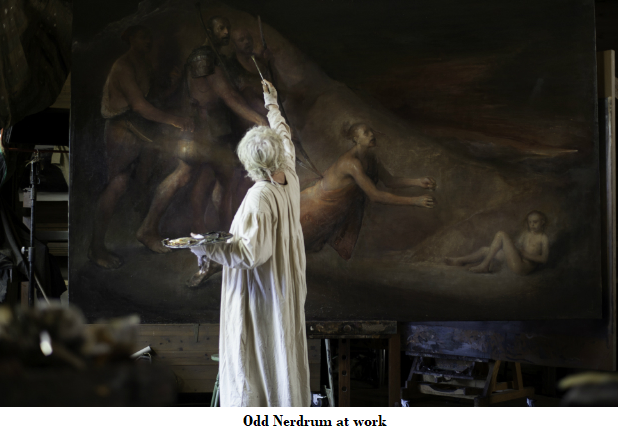
As certain pictures held in the collections of the royal houses and public galleries of Denmark, Sweden, Finland and Norway demonstrate, there was once a more or less familiar style of painting which may be called the Dark “Nordic” or “Scandinavian” School, which was at once Realistic and Romantic, as well as being strongly influenced by the work of Rembrandt and his followers in the Netherlandish School. This often rather dour, even if remarkable, type of painting gradually fell out of prominence and favour in the North, once the turn of the twentieth century had brought an interest in brighter colours and sunlight, but the bleaker and darker tradition never really disappeared. A mixing of the two approaches is seen in pictures by the Danish painter Vilhelm Hammershoi (1864–1916), whose spare and impressive work has been explored by Michael Palin in his television series on artists.
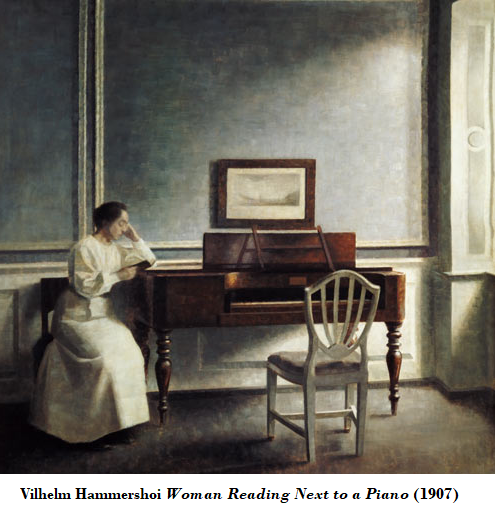
The leading painter in the most recent revival of the darker Nordic style is Odd Nerdrum (born in 1944). Whilst his work as a whole is deeply evocative of themes traditionally associated with the Scandinavian countries, some of his pictures are startling in their subject matter and even eerie in their themes, after a distinctively Nordic/historical fashion. Nerdrum is an unusual figure with a very interesting history.
This essay appears in December’s Quadrant.
Click here to subscribe
At the outset, we must deal briefly with two aspects of Odd Nerdrum which have proven very controversial: first his conviction in the Norwegian courts for tax evasion; and second the opprobrium heaped upon him by the non-figurative contemporary “art establishment”. Australians, 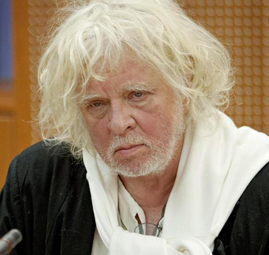 many of whom (and including among them plenty of committed republicans!) have every reason to be thankful for the exercise of the Royal Prerogative of Mercy by English monarchs from about 1786 onwards, may warm their hearts to the graciousness of that fine sovereign King Harald V of Norway, who in 2017 granted to Odd Nerdrum a royal pardon from the tax evasion convictions which had dogged Nerdrum (right) through legal proceedings, appeals and re-trials, for some years. It was alleged that a large sum of money held in an overseas bank account was taxable income, whereas Nerdrum claimed that the money was a fund he had had to dedicate to the expensive business of restoring many of his pictures from the 1980s, when he had used a mixture of painting materials intended to reflect the media of Old Masters such as Rembrandt, but which proved to be so unstable as they aged that the pictures had started to deteriorate and had to be restored or re-worked. The Norwegian tax authorities ultimately succeeded in obtaining a conviction against Nerdrum on the basis that the court did not accept that the funds were a dedicated deposit or fund set aside for that business aspect of his practice as an artist. The case bitterly divided Norwegian opinion, especially amongst its various art cliques.
many of whom (and including among them plenty of committed republicans!) have every reason to be thankful for the exercise of the Royal Prerogative of Mercy by English monarchs from about 1786 onwards, may warm their hearts to the graciousness of that fine sovereign King Harald V of Norway, who in 2017 granted to Odd Nerdrum a royal pardon from the tax evasion convictions which had dogged Nerdrum (right) through legal proceedings, appeals and re-trials, for some years. It was alleged that a large sum of money held in an overseas bank account was taxable income, whereas Nerdrum claimed that the money was a fund he had had to dedicate to the expensive business of restoring many of his pictures from the 1980s, when he had used a mixture of painting materials intended to reflect the media of Old Masters such as Rembrandt, but which proved to be so unstable as they aged that the pictures had started to deteriorate and had to be restored or re-worked. The Norwegian tax authorities ultimately succeeded in obtaining a conviction against Nerdrum on the basis that the court did not accept that the funds were a dedicated deposit or fund set aside for that business aspect of his practice as an artist. The case bitterly divided Norwegian opinion, especially amongst its various art cliques.
Which brings us to the second controversial aspect. This is bound up both with the traditional nature and subject matter of Nerdrum’s work over the years and also with his rather unusual personality—and the latter of course derives from his particular life experience, which will be mentioned below. Some of Nerdrum’s early work, and indeed much of his later work, includes pictures which many find offensive or verging on the pornographic, although that is no new thing in the long history of art. Yet even this is not the thing that excites the greatest animus against Nerdrum in some quarters of the public in his homeland. What is for most in the new “art establishment” inexcusable and unforgivable about Nerdrum is his persistence in the advocacy and practice of Figurative art and in particular the traditional techniques of painting, as opposed to Abstraction and its ilk and all the other apparatus of contemporary “art practice” (as its adherents prefer to call it) including semiotics, verbal art, conceptual art and all the rest. Nerdrum’s work is dismissed by some of the noisier art critics and commentators in Norway as being non-art or indeed, as being “kitsch”. He has become, as it were, beyond their ken—and thus beyond the pale—for many in today’s enormous “art establishment”.
It is no accident then, that Nerdrum came to share a podium on one memorable occasion with Sir Roger Scruton, in a remarkable discussion about the state of the visual arts. Indeed, Nerdrum’s Art School in Norway could even be described as the artistic equivalent of Scruton’s underground university activity in Eastern Europe during the Cold War. Like many artists, Nerdrum has his pet theories and views about the influence of social and philosophical thought on the history and practice of art and particularly of the painting of pictures. He was scathing in particular about what he saw as the baneful influence of Kantian Idealism on European art. Whilst one cannot pretend that Nerdrum has been totally consistent in his pronunciamentos about such matters, he is a well-read man and his comments have considerable force and aptness. All of this, of course, brings him into some sharp conflicts.
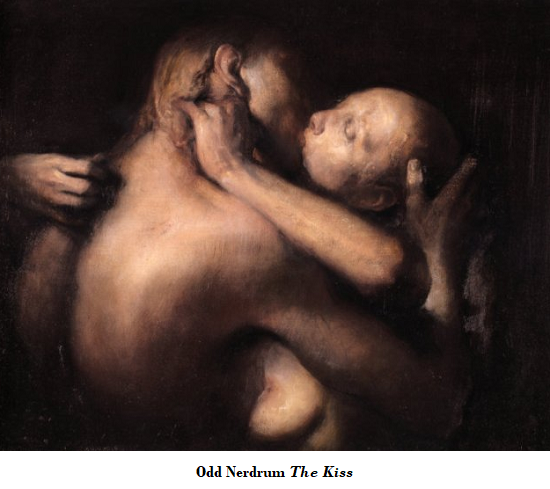
Nerdrum at first sought to defuse the slings and arrows of the contemporary art panjandrums about his works being “kitsch”, by adopting that very word to describe his works as kitsch and not “art”; but soon his followers and other commentators caused this usage to get such a wide currency that it has become almost a badge of honour for certain groups of those painting in the Traditional and Figurative styles. It is not proposed here to delve deeply into this whole controversy, which might, after all, be described as merely a matter of labelling. So it may be best to proceed by first noting some particular illuminating things about Nerdrum’s origins and his upbringing and his art education; and then to mention and discuss some of his major pictures and themes. This is entirely consistent with the salutary advice and approach of sane art lovers and critics such as the late Sir Denis Mahon, who repeatedly pointed out that what is important about art, and especially paintings, is not merely the ideas that may lie behind or be expressed in them, but that pictures are ultimately “opere fatto per mano” and should be appreciated for what they are in themselves and what they portray, before one gets too far bound up with concepts and agendas and historical “significances”.
Odd Nerdrum is Norwegian but was born, in 1944, at Helsingborg in Sweden where his parents had fled from the German occupation of Norway. Only in 1993 did Nerdrum discover that his biological father was the architect David Sanfed and not Johan Nerdrum. He attended a Rudolf Steiner school rather than ordinary schooling. Some might say this is part of the problem for Odd Nerdrum; others would say that the special nature of the Steiner schooling was beneficial for Nerdrum’s artistic development. He later attended the Art Academy of Oslo, but was soon disillusioned with both its teachings at the time and also with Modernist art generally. He left the academy and taught himself in a traditional style much influenced by Caravaggio and Rembrandt. In the 1960s he studied with Joseph Beuys in Germany.
The US art critic Richard Vine considers Nerdrum’s personal history led to “a conflicted occupation with origins and personal identity” which ultimately became reflected in many of his paintings. It is telling that Nerdrum emphatically describes himself as a “painter” and not an “artist”, so as to make clear his fundamental belief that first and foremost the work of a painter is to paint pictures and not to theorise art. All of this might be stated in terms of the old and true maxim Faber fit in fabricando and Aristotelian notions of the artist as being primarily a maker of things, informed and enabled by certain skills of hand and eye.
Vine has identified, along with Rembrandt, Caravaggio, Masaccio, da Vinci, Michelangelo and Titian, the following as influential for Nerdrum’s development: Goya, Chardin, Millet, Fuseli, Friedrich, 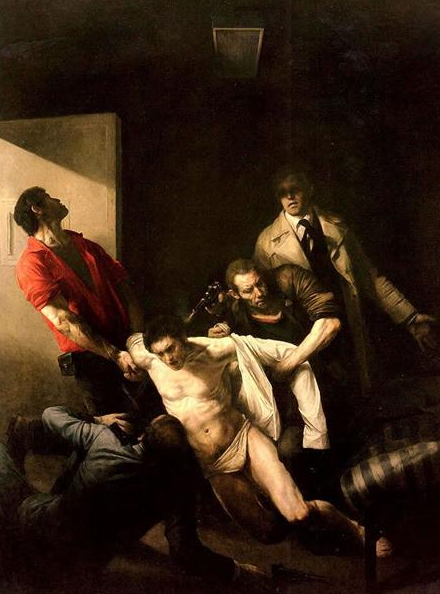 Munch, Dali, Soutine and Lars Hertervig. In his student years Nerdrum was vastly impressed by Rembrandt’s The Conspiracy of Claudius Civilis (1661) in the National Museum at Oslo. He was finally turned off Modernist art when he saw, in the Museum of Modern Art at Stockholm, Rauschenberg’s work Monogram comprising a stuffed goat cinctured with a motor tyre. Nerdrum’s early works were large-sized representational pictures, more often than not with themes challenging socially accepted ideas. An example was his picture The Arrest (left), which pre-dated his very large Refugees at Sea (1979-80) depicting Vietnamese boat people (below) of that period, a work he later doubted as naive. After 1981 or so, Nerdrum produced a body of starkly realistic works, some of which shocked segments of the public. The works depicted individuals or small groups seen in empty and still landscapes, most often with a sense of foreboding in weather features or the odd quality of light. The people are portrayed in primeval furs or skins and often with caps and traditional and sometimes modern weapons. Their settings suggest the apocalyptic, or scenes of the breakdown of modern society and the reversion to the state of nature in the Hobbesian, not Rousseauvian, sense.
Munch, Dali, Soutine and Lars Hertervig. In his student years Nerdrum was vastly impressed by Rembrandt’s The Conspiracy of Claudius Civilis (1661) in the National Museum at Oslo. He was finally turned off Modernist art when he saw, in the Museum of Modern Art at Stockholm, Rauschenberg’s work Monogram comprising a stuffed goat cinctured with a motor tyre. Nerdrum’s early works were large-sized representational pictures, more often than not with themes challenging socially accepted ideas. An example was his picture The Arrest (left), which pre-dated his very large Refugees at Sea (1979-80) depicting Vietnamese boat people (below) of that period, a work he later doubted as naive. After 1981 or so, Nerdrum produced a body of starkly realistic works, some of which shocked segments of the public. The works depicted individuals or small groups seen in empty and still landscapes, most often with a sense of foreboding in weather features or the odd quality of light. The people are portrayed in primeval furs or skins and often with caps and traditional and sometimes modern weapons. Their settings suggest the apocalyptic, or scenes of the breakdown of modern society and the reversion to the state of nature in the Hobbesian, not Rousseauvian, sense.
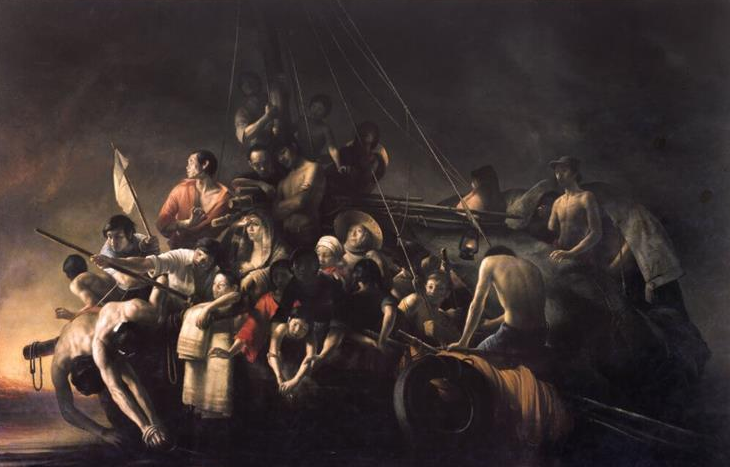
Alongside these more disturbing works, Nerdrum has also painted a large variety of self-portraits over the decades: here again he resembles his idol Rembrandt. One or two of his depictions of himself are of the epater les bourgeois type, serving to make him notorious and feeding his enemies. Many others amount to a solid body of intensely observed self-awareness of the visage, the passage of time and the human condition generally, expressed superbly, with all the authority of kindred Rembrandt works. Of course, again his critics dismiss these as derivative and imitative and some even liken them to vanity pieces like Durer’s. However, the objective viewer must recognise in Nerdrum’s self-portraits (a small sampling below) an aspect of his oeuvre which will live in history. Nerdrum has also painted a large variety of still-life works, increasingly of humble and everyday objects such as building bricks, a favourite trope.

Nerdrum must be placed squarely in that line of Scandinavian figurative and representational artists such as the Swedish Realist master Anders Zorn (1860–1920) and the more enigmatic Dane Hammershoi, with both of whom Nerdrum’s work has resonances. Indeed, in student days at Dusseldorf in the 1960s, Nerdrum was dubbed by his fellow students with the nickname “Zorn”, no doubt then in some scorn.
Yet there is one telling aspect of Nerdrum’s body of work which is especially worth noticing, and that is the series of apocalyptic and foreboding pictures of persons and groups placed in mysterious and glowering landscapes, eerie and deserted but pregnant with dire threats. Some of these in recent years, when Nerdrum was fighting protracted legal proceedings against him, can be seen as self-dramatic. At the same time, certain of these pictures contain brilliant evocations of the personification of self-satisfied, self-serving and evil officialdom, one such figure capturing to perfection the supercilious smirk of the epitome of the “cancel culture” operative, in a scene where a tribunal sits to condemn the artist to execution.
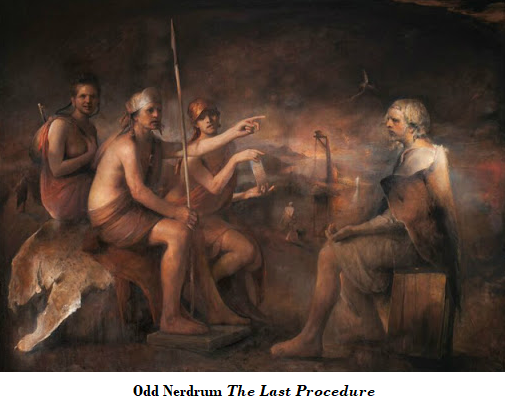
However, most of these eerie pictures also have a wider and more ominous significance for what they have to say about certain tendencies which are gathering pace today. In this regard, these works are not merely “portentous”, as it might be said. They raise serious questions about nefarious forces that are afoot in today’s world. The growing power of the operatives of “cancel culture” is one theme that Nerdrum captures and depicts with terrifying precision. Certain others of his works before 2000 might be seen as prefiguring the attacks on the United States and the West generally from 2001 onwards; and an indication of what might be the ultimate effect of the traducing of the West—a plethora of isolated families and small groups, foraging for themselves and forced to defend themselves in the traditional manner.
There also exists a remarkable piece of film, which one can see on the internet, where Nerdrum and some of his friends and family visit The Hermitage in St Petersburg. Here Nerdrum is seen in his element, enthusing and admiring some of the greatest of Rembrandt’s works.
He takes his party to a cabinet in a side gallery containing some small ancient Greek terracotta figures, which he says were “trifles” produced for ephemeral purposes such as mourning rites (almost like the cheap market “fairings” of Victorian times), but the figures are, as Nerdrum points out, astounding in their artistry and subtlety and are worthy of more study and publication than they currently receive. However, the mood and tone changes dramatically when Nerdrum arrives before the “Danae” picture, ruined in parts by an idiot acid-thrower some years before; now Nerdrum was seeing for the first time the “restoration” job done at The Hermitage in an attempt to remedy this damage. He is so appalled at the ineptness of the “restoration” that he demands of the nearest attendant curator that better should be done; she asks by whom and he immediately offers his services, which are none too politely ignored. One American journalist reported this encounter in the mistaken belief that Nerdrum was pained by the extent of the damage done by the acid-thrower; when in fact it was the inept work of “restoration” Nerdrum meant when he said, “So much damage done!” The whole matter of “restoration” and “conservation”, which increasingly attract public attention, funds and art officialdom, is a vexed one—and Nerdrum is well qualified to regret the treatment of this great Rembrandt.
The circumstances of Nerdrum are a telling indication of the dire situation of contemporary “values”. Nerdrum, one of the world’s leading traditional and figurative artists, was faced with two or more years of imprisonment at the urging of Norwegian tax authorities for tax evasion, whilst Breivik the terrorist who machine-gunned about seventy young people in a mass murder some years back, could only be imprisoned for a maximum of twenty-one years under the relevant Criminal Code.
If you are a reader of Quadrant aged, say, fifty or so, then during your lifetime, since about the time of the bombing of Beirut in the 1970s, we have had thrust at us, almost nightly, scenes of carnage and broken cement and steel renderings, dust and rubble, not only in the Middle East, but widely elsewhere. Yet most in the West never stop to ask exactly why is this so? Consider the settled and ordered worlds seen and painted in France, Germany and Spain, by painters such as, respectively, Henri Lebasque, Max Liebermann and Joaquin Sorolla. One needs to ask by whom and why must scenes of such humane and enriching ways of life be destroyed and obliterated. The answer lies in part in the middle term above: Max Liebermann’s idyllic home on the Wannsee in Berlin is now an art museum and shrine to that delightful man and artist. But of course, just down the road is the building where the Nazis held the Wannsee Conference to craft the “Final Solution”, all neatly taken down by stenographers and duly typed up and circulated to those with a “need to know”. The epitome of modern bureaucracy and ultimate “cancel culture”. Is it just “retail sanity and wholesale madness”? No, it is much more: it is the widespread nature of evil, envy and hatred of talent.
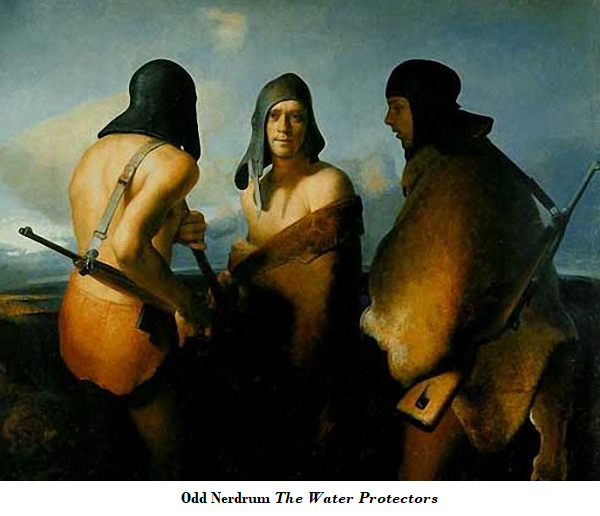
We now also see, almost weekly, a political class around the world which seems either impotent in the face of, or worse complicit in encouraging, groups and forces which are the avowed enemies of the West and of all the best in its traditional heritage. This is allowed to happen by virtue of the appropriation from the West of one of its distinctive values: tolerance. That is then weaponised back upon the West, accusing it of “intolerance”. The reason for this is that today, by far the largest part of the populace in the Western nation-states is now so far removed from the realities and privations, the long struggles and bloody battles, which enabled the emergence of a tolerable life for most in those nation-states, that they blithely assume that such a state can simply go on forever, regardless of the jeopardy caused by the undermining by its own discontents and also by the agents of external malice and aggression. Others who have no such luxuries as the inheritance of the West confers, have no such illusions, so their determination is at once grim and ruthless.
Nerdrum’s dark and bleak pictures of individuals, couples or families lost in windswept and threatening landscapes, with their sidearms or rifles at the ready, whether for hunting food or self-defence, offer a sharp reminder of basic realities to come or not far away. Now, plague is added. Such matters and many of Nerdrum’s apocalyptic pictures remind one of the chilling concluding lines in W.H. Auden’s poem “The Fall of Rome”:
Unendowed with wealth or pity,
Little birds with scarlet legs,
Sitting on their speckled eggs,
Eye each flu-infected city.
Altogether elsewhere, vast
Herds of reindeer move across
Miles and miles of golden moss,
Silently and very fast.
Dr Douglas Hassall, who lives in Melbourne, has been a contributor on art and other matters to Quadrant for many years
 Sign In
Sign In 0 Items (
0 Items ( Search
Search









Wonderful essay and, clearly a wonderful subject. However, non-engineers must note: “broken cement and steel renderings”, it’s CONCRETE, not cement. Cement is to concrete what flour is to cake, similar colour too.